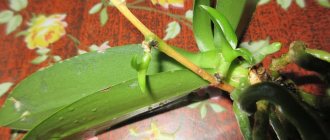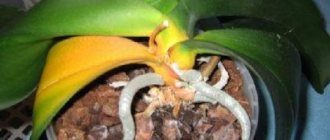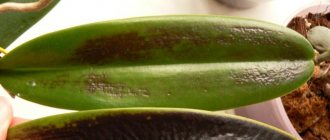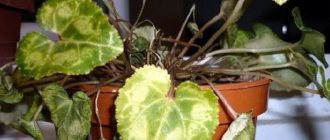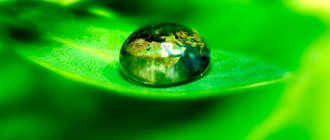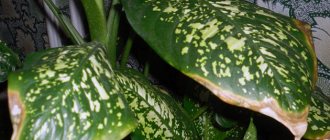Plants » Flowers
2
1662
Article rating
Kira Stoletova
Orchids are moderately demanding of the conditions created for them; many factors influence the growth and development of the flower. There are a number of reasons why an orchid turns yellow. You can save flower stalks and prevent the infection from spreading further, the main thing is to start treating the plant in a timely manner.
Causes of yellowing orchids
Watering
- Poor quality of watering is the first reason for poor health. Do not use hard water filled with excess salts and metals. If this is the cause of the plant’s painful condition, then the lowermost leaves of the orchid will be the first to turn yellow, and all subsequent ones will be covered with yellow spots. If the plant is dormant, it needs to be urgently transplanted into a new substrate. If flowering is in full swing and replanting is impossible, water the plant with distilled water diluted 50/50 and regular water that has settled from the top to the base.
- Lack of moisture - check the soil regularly; if it dries out, place the flower pot in a large container of water for 30 minutes, then let the water drain completely and return the phalaenopsis to its original place.
- Excessive watering will lead to rotting of the roots, their lethargy, weeping spots will appear and the leaf will soon fall off. If overwatering occurs and the root rots, then you should transplant the orchid into a new substrate, removing the damaged areas, but first wait for it to bloom.
Yellowing of the peduncle
Let's try to understand in detail why the peduncle of an orchid turns yellow and what to do to prevent it?
In most situations, yellowing of the flower arrow does not cause any fear or anxiety among gardeners. Leaves may turn yellow and fall off. And they give you the opportunity to grow young and strong. The green color of the plant is provided by the pigment chlorophyll. It will be used up quite quickly - no more than 3-4 years.
The flowers have faded. We need to take care of growing new flowers. This is a natural process. If the age of the orchid allows.
With natural aging
After the flowers fall, the peduncle itself begins to turn yellow from the top. With normal development:
- In sympodial orchids it is eventually removed. But not pseudobulb. And they examine the plant carefully. Are new flower stalks appearing?
- If the peduncle of a monopodial plant turns yellow , what should you do? Take your time when trimming the peduncle. Consider the features of the species. And even varieties: The peduncle is removed when completely dry ;
- In some Phalaenopsis (Multiflora), the peduncle continues to grow and form new buds;
- In other species, the peduncle can be used at your discretion. Depending on the variety, your experience and imagination: Cut off the dry part of the peduncle above the dormant bud . And you are waiting for the formation of new flower stalks or children. You can even stimulate their appearance in various ways and techniques;
- Cut off the flower stalk almost at the base . Leave 2-3 dormant buds on it. For those who love strong and tall peduncles. And they give preference to the decorativeness of the plant rather than the number of flowers;
- Do not forget. Even in an apartment, you can get new plants from peduncle cuttings if you create the right conditions.
Important! With bulbous orchids everything is simpler. They have bloomed. They have shriveled up. Waiting for new ones. You can dig up the bulbs and plant them.
As a manifestation of various ailments
The change from green to yellow in orchids is not always healthy or natural. Flower growers also have to deal with unfavorable moments. Or factors.
They can occur regardless of the state of plant care.
But quite often our actions lead to undesirable results . Even destructive.
What are the dangers of the process?
Such changes can be quickly detected if you constantly monitor the condition of your plants. And take appropriate measures. Then the danger will disappear.
If the reasons are not eliminated. And you didn't do anything? The plant may simply die. Not to mention the loss of the peduncle.
Main reasons
Excess or lack of fertilizer
The value of fertilizers lies in their timely and dosed application in accordance with the recommendations of specialists and the advice of flower growers with experience:
- The lack of certain elements does not allow the plant to gain strength and fully bloom . Especially the lack of magnesium, boron, phosphorus, potassium:
- And fewer buds are formed. They may fade and not even bloom;
- The flowers are small and not as promised. And they bloom faster.
- Too much fertilizer is much more dangerous. The plant itself is simply tortured by their use. Along with the peduncle. Not only before flowering, they are not even able to form buds;
- And you just have to choose the right options.
Incorrect lighting
Orchids are very light-loving plants . Under natural conditions, they grow in places where there is enough of it. And in the apartment it is necessary to regulate.
for 12-14 hours a day . But direct sunlight is dangerous for the plant. The result is sunburn, burnout, and pale leaves.
And lack of light inhibits photosynthesis . Leaves and roots may dry out. And flower stalks will not ensure the formation of buds and their blooming.
So flower growers are looking for various methods and techniques to provide the necessary lighting:
- Curtains and drapes;
- Choice of southern and eastern sides;
- Backlight.
Unregulated air humidity
Air humidity for an orchid is closely related to temperature:
- As the temperature rises, increase the humidity;
- When the temperature decreases, high humidity leads to wilting of the plant and its peduncle. It also contributes to the development of various diseases and decay.
Diseases
Diseases of the leaves or roots will certainly affect the peduncle. There are many infections.
And yellowing of the peduncle can only confirm the danger of the situation and the need to take action.
Keep a close eye on the roots and leaves!
Damage
Orchids are fragile plants:
- Unsuccessful transportation or falling plants can lead to damage;
- Broken and cracked peduncles come out of such situations in different ways. They may turn yellow and dry out.
Stress
Plants do not really like rearrangements and transplants . Especially during flowering:
- She may not like your desire to move the orchid away from the sun to another place. As well as changes in temperature, lighting;
- This can also affect flowering (the condition of the peduncle, the formation of buds). To get used to other conditions.
What to do?
Don't do hasty actions . As in life, so with orchids. Knowing the characteristics of your orchid will help you do this.
It is not always possible to immediately determine the exact cause of the drying out of the peduncle. But constant inspection of the plant allows you to do this correctly and faster.
Moreover, you need to inspect all parts:
- Leaves, their connections with the stem;
- Pseudobulbs;
- Transparent containers allow you to determine the condition of the roots. And the quality of the substrate.
Important! You may even need to remove the plant from the pot.
Should I delete it?
So you saw a yellowed peduncle and what should you do? You decide for yourself after a visual inspection and assessment of the condition of the entire plant and peduncle. But still there is no need to rush:
- Watch. Consult experienced flower growers;
- It is very likely that you will delete it. But a little later. With knowledge of the matter.
How to slow down the process?
Even simple actions can prevent further yellowing of the peduncle. It can be:
- Changing the location of the flower;
- Good and proper watering. If you see dried substrate;
- Adjusted humidity and temperature.
Fertilizers
If a previously healthy home orchid has suddenly turned yellow and dried out, the cause may be an overabundance of fertilizers. When the stem and flowers wither and the leaf falls off, you can save the phalaenopsis. To do this, rinse the substrate or replant the flower; you cannot feed it for the next few months; after that, only with diluted fertilizer.
If only the tips or lower leaves turn yellow and wrinkled, then the orchid suffers from an excess of calcium. Change the substrate. In this case, for a while the need for feeding disappears. If the orchid turns yellow on top, veins appear on the leaves and fall off over time, then the reason is a lack of potassium - use a special fertilizer.
Diseases
The orchid dries out from fungal infections; they occur with frequent watering and affect the root system and trunk of the flower. If rotting is not stopped in time, it will also affect the leaves, causing them to turn yellow and fall off. It is necessary to take immediate action - replace the substrate, trim the affected areas and treat the phalaenopsis with an antifungal drug. For prevention, use fungicides.
Due to bacterial infections, the leaves turn sharply yellow, darken over time, become limp and wrinkled, and weeping spots appear with an unpleasant smell of rot. Isolate the plant, trim off the affected areas and treat the sections with iodine. Only after treatment with an antifungal drug can the flowerpot be returned to its original place.
Dropping buds after purchase
After purchasing the orchid, new growth conditions are created - and this can cause budding to stop or the already opened inflorescences to drop.
To restore its former decorative appearance, the flower needs to go through an adaptation period, which takes from 2 weeks to 2 months.
Many flower growers, when purchasing orchids, adhere to a little trick: in order for the flower culture at home to bloom and the inflorescences not to fall off, they purchase those specimens that have the smallest number of open corollas and a predominance of closed buds.
Another reason for failure to bloom is possible frostbite of the root system caused when transporting the plant from the store to home. The best time to buy is summer.
Pests
Most of all, ticks and white-winged moths love the orchid. Due to mite infestation, the roots and trunk of the plant do not receive enough nutrients and moisture, the leaves are the first to react, they turn yellow and lose their elasticity. To save the flower, treat it with a special preparation and, after completing a full course of spraying, transplant it into a new substrate. When whiteflies appear, the flower is covered with a white, fine-grained coating, the leaves quickly wither and fall off, and the flower stalks may dry out. To restore the leaves, use a soap solution, it will remove plaque, then spray with a special solution against pests. The procedure is repeated for several weeks in a row until complete recovery.
Prevention
You don't need to focus too much on the flower stalk. Its condition depends entirely on the entire plant (complete and healthy roots and leaves). And for this you need to comply with the conditions of keeping the orchid. The species you grow:
- Temperature and humidity should complement each other. Don't contradict. Maintain them at any time (both summer and winter);
- Lighting. Scattered and prolonged. Choose suitable sides in your apartment. Additional lighting only benefits plants. Florists recommend using phytolamps;
- Select the appropriate watering mode. It is not always the same at different stages of development. Summer is not the same as winter. And spraying cannot always be carried out;
- be fed correctly. No overkill;
- Use containers, pots, and vases that are convenient and appropriate for the look . Monitor the condition of the soil. It must be replaced after 2-3 years;
- Carry out preventive treatments against diseases . Keep pests away. When they appear, do not hesitate to take action.
Age
Old leaves may turn yellow and fall off
Leaves may turn yellow and fall off due to old age, but in their place, new, young, light green leaves will certainly grow. Usually the process begins with the lowest leaves, gradually rising up the trunk of the flower. There are also phalaenopsis hybrids that necessarily shed their foliage during flowering.
cramped potty
If the orchid has dried out and looks sickly, the cause may also be unfavorable growing conditions.
When the plant has grown and most of the roots are already outside the pot, or are squeezed in it, the roots become deformed and dry, the penetration of moisture and nutrients is difficult, as a result the leaves turn yellow and begin to fall down. Transplant the phalaenopsis into a pot of a suitable size, dividing it if necessary, being careful not to damage the buds and flower stalks. After transplantation, the plant will quickly return to normal.
What to do?
If the peduncle is still green and the tip has begun to turn yellow, there is no need to remove it. For a visually attractive look, you can cut off the dry tip. We remove the entire dry peduncle, which will give strength to restore the orchid. For the elimination process you will need pruning shears or a sharp knife. Disinfect all instruments in advance.
- Visually inspect the plant, leaves, aerial roots, stem.
- If the orchid is planted in a ceramic pot, you need to remove the flower and feel the roots for rotting.
- Using garden pruners, make a cut 1 cm above the living bud. If there is no such thing, then leave the stump no more than 2 cm.
- Sprinkle the live cut with an antiseptic.
- If there are dry leaves and roots, remove them in the same way.
- Do not water the flower for 7-10 days, let it recover.
After the operation, it is best not to touch the orchid.
- Minimize watering.
- Eliminate fertilizing.
- We limit the duration of exposure to light.
- We lower the temperature.
And with the onset of spring, we return everything to its place.
Stress
Orchids are delicate and capricious, sensitive to any changes. Changing lighting and temperature conditions, or moving to a new place are stressful. If the leaves turned yellow and fell off after the above changes, there is no need to guess why the flower dried up. The flower should get used to stressful situations gradually - move the pot to a new place for a couple of hours, then return it back.
The flower's homeland is the tropics, hence the love for humid environments. Dry air will cause leaves to turn yellow, dry at the tips and fall off. To revive it, provide the right level of humidity with a humidifier or frequent spraying, and the flower will quickly return to normal. If the soil is dry, rinse it under running water.
Preventive measures
In order for the orchid to be full of strength and health, so that it has no reason to get rid of buds and flower stalks, experienced orchid lovers advise adhering to the following rules:
- the temperature of keeping plants in summer should be from +22 to +25°C, and in winter from +16 to +18°C;
- maintain diffused lighting;
- optimal air humidity for orchids is 50-60%;
- provide regular ventilation, avoiding cold drafts;
- the soil should be updated no more than once every 3 years;
- watering once a week after the soil has completely dried;
- water for spraying and watering should be warm (2 degrees warmer than in the room) and clean;
- Fertilizers should only be applied to healthy plants once every 2 months;
- If there is a lack of air humidity, carry out up to 5 sprayings per day.
Care instructions
If the care rules are followed, but the orchid still dries out, try the following tips:
- Alternate the method of watering - immerse in a large container of water, and next time water from above, avoiding the lower leaves and trunk.
- Spray the flower regularly with warm water.
- If the roots are bright green, there is enough moisture in the substrate, if they have lightened and become silvery, water them immediately, the soil is drying out.
- After flowering, do not cut the flower stalks at the root; if they have not dried out, leave them alone, and after a while, carefully trim the dry areas.
- Use special soil for orchids, it contains pieces of bark.
- Cover the earthen ball with moss, this will protect it from drying out and retain moisture inside the pot.
- An orchid is replanted only during the dormant period, until the bulb appears and the peduncle has dried up.
If the phalaenopsis does not bloom for a long time, place it in a dark room and later return it to its place. A contrast shower also helps a lot - warm water first, then cool water. Soon she will delight you with a young shooter.
The structure of an orchid
Get to know your orchid more thoroughly . To understand what is happening with the peduncle:
- What type of orchid. And from what distant lands does she come?
- How best to care for her. What suits her and what is contraindicated;
- What is the structure of the whole plant?
The most popular and famous among gardeners are Phalaenopsis, Dendrobium, Vanda, and Cattleya . But there are still many beautiful representatives of orchids.
The types are different, but the type of growth can be of two options.
Orchids are divided into monopodial and sympodial species.
Sympodial
These are types such as:
- Cymbidium;
- Miltonia;
- Dendrobium;
- Cattleya;
- Odontoglossum;
- Oncidium.
What unites them:
- Several shoots grow horizontally . There may be a dozen of them. But not alone;
- The shoots are united by one rhizome (rhizome). It is located in the ground;
- Such orchids have several growth points ;
- Vertical sprouts grow into pseudobulbs: She lives 2-3 years;
- In a mature pseudobulb, the apical bud shoots out an arrow or dries out;
- After the formation of a peduncle with flowers, the pseudobulb does not grow. New shoots appear at its base.
- At the top of the shoot;
Monopodial
This:
- Phalaenopsis;
- Wanda;
- Brassavalia;
- Angrekum;
- Vanilla.
Description:
- They do not have a rhizome or pseudobulb ;
- One vertical stem is quite noticeable : And it has only one growing point;
- It grows upward, and leaves form on the sides of the stem. In sequence.
- Short and almost invisible in Phalaenopsis;
- In the axils of the leaves, aerial roots or flower stalks may form from the buds.
It is the type of growth that determines the actions in relation to the arrow. Including when it turns yellow.
